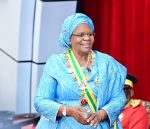In a striking reframing of conventional economic wisdom, President Netumbo Nandi-Ndaitwah declared Namibia’s recent reclassification as a Lower-Middle-Income country not a setback, but a crucial opportunity to unlock vital resources for equitable development. The announcement came during the landmark launch of Namibia’s 6th National Development Plan (NDP6) at the University of Namibia yesterday, where the President detailed the nation’s progress in her first three months and charted the ambitious course towards Vision 2030.
For years, Namibia grappled with the constraints of being labelled an Upper-Middle-Income nation by international financial institutions, primarily the Bretton Woods duo of the World Bank and International Monetary Fund. This classification, based solely on average per capita income, painted a misleading picture of national prosperity. “This classification was flawed in principle,” President Nandi-Ndaitwah stated unequivocally in her address, “as it overlooked the skewed distribution of resources.” The consequence was stark: the label significantly hampered the Namibian government’s ability to access essential development grant funding and affordable financing instruments critical for bridging the nation’s vast inequality gap and funding large-scale infrastructure and social programmes.
The formal reclassification, effective July 1st, 2025, is therefore presented not as a mark of failure, but as a necessary and welcome correction aligning international perception with Namibia’s economic reality. “The most recent re-classification of Namibia… to a Lower-Middle-Income country… is deemed more responsive to the reality of the structural imbalances of our economy and large Inequality Gap,” the President explained. This shift in status is expected to be a game-changer for the newly launched NDP6 (2025-2030), the final five-year plan before the culmination of Namibia’s Vision 2030. “Based on this revised classification,” President Nandi-Ndaitwah emphasised, “Namibia will be more eligible to access grant funding and financing instruments on more affordable terms. This is beneficial to our developmental agenda and ambitions to foster inclusive growth and shared prosperity.”
This unexpected silver lining within an income downgrade underscores the profound challenge Namibia faces: translating natural resource wealth and relative macroeconomic stability into tangible benefits for all its citizens. The previous National Development Plan (NDP5) explicitly aimed to escape the “middle income trap” – a situation where a country attains a certain level of income but stagnates, unable to transition to high-income status due to factors like lack of industrial diversification, low innovation, and entrenched inequality. The reclassification acknowledges that Namibia, despite its mineral riches and stable governance, remains firmly ensnared in this trap, its growth constrained by deep-seated structural issues masked by the previous statistical veneer.
NDP6, therefore, arrives at a pivotal moment, framed by the theme “Fostering Economic Growth, Inclusiveness and Resilience for Quality Sustainable Development.” Its core mission is to propel Namibia towards becoming a “developed and industrialized nation” by 2030, directly confronting the root causes of poverty, unemployment, and inequality that the income reclassification now more accurately reflects. The plan rests on four pillars: Economic Growth, Transformation and Resilience; Human Development and Community Resilience; Environmental Sustainability; and Good Governance and Effective Public Service Delivery.
Crucially, the President linked the potential unlocked by the reclassification to NDP6’s aggressive industrialisation drive. “Our unemployment rate is high because, among other drivers, our industrial capacity remains limited,” she noted. Consequently, NDP6 places “due policy emphasis on mineral resources beneficiation and value-addition” – moving beyond simply exporting raw materials like diamonds, uranium, and now oil and gas, to processing them within Namibia, creating higher-value products and, critically, more jobs. This focus on building advanced industrial capacity is seen as essential for absorbing the burgeoning youth population, which the President described as “an opportunity and not a burden,” with Namibia’s population expected to reach 3.5 million by 2030, predominantly of working age.
The first three months of the 8th Administration, the President reported, have been marked by a “decisive shift towards a governance culture that is strategic, responsive and performance-driven,” laying the groundwork for NDP6 implementation. This includes forming a leaner 14-Minister Cabinet, appointing all Regional Governors, and directing Ministers to align their performance agreements directly with NDP6 objectives, guided by the leadership values of Pragmatism, Accountability, Integrity, Meritocracy and Inclusivity (PAIMI).
Significant strides were reported across the seven Priority Sectors outlined in the President’s inaugural address, sectors intrinsically linked to leveraging the potential benefits of the new income classification:
Agriculture: Operational Green Schemes produced significant harvests (9,947 tonnes maize); new sites identified (Katima Farm, Ekoka); land acquired for resettlement (Farm Richlyn); progress on Neckartal Dam irrigation; seed processing facilities established; drought relief provided to 1.4 million people; and a mutton/chevon export protocol signed with China.
Sports: Sites identified for 16 sports centres of excellence; progress on CAF Category stadiums in Windhoek, Eenhana, Nkurenkuru, and Mariental; funding formula for sports sponsorship nearing completion; and successful hosting of the Region 5 Youth Games creating over 1,600 jobs.
Youth Empowerment: National Youth Fund capitalised with N$257 million plus N$5 million from NamibRe; secured guarantee facility for youth entrepreneurs; Global Accelerator funding secured; support provided to over 200 youth-led businesses; and internship placements facilitated across government and private sector.
Quality Education & Training: Work underway to eliminate tuition fees in public HE and VTC from 2026; new funding formula implemented; minimum standards rolled out; infrastructure expansion and TVET reform advancing.
Creative Industries: Revitalisation of National Arts Awards; draft amendments for Creative Industry Infrastructure Fund prepared; hosted international film productions boosting jobs and revenue; and broadband access expanded.
Quality Health & Social Welfare: HPV vaccine rollout; extended clinic hours; sites identified for new clinics; Khomas District Hospital groundbreaking; ambulance procurement; mental health centre renovation; and moves towards direct pharmaceutical procurement.
Land, Housing & Sanitation: 3,492 housing units under construction; informal settlement formalisation progressing; 10,000 erven being serviced; and 1,019 new toilets completed.
The President emphasised that these priority sectors are underpinned by Critical Economic Enablers, where progress was also detailed:
Mining: Policy development on mandatory local equity in new mining ventures; efforts to legislate mineral beneficiation; consultations on establishing a national gold reserve.
Energy: Namibia’s Energy Compact finalised securing funding; agreements with Regional Electricity Distributors; progress on multiple renewable energy projects (solar PV, biomass); Nuclear Energy Taskforce established; port cranes acquired for Lüderitz.
Oil & Gas: Preparatory work begun for Oil and Gas Logistics/Supply Base; upstream petroleum unit moved to Presidency; benchmarking visits conducted.
Tourism: National Tourism Spatial Master Plan development started; Visa on Arrival generated N$171 million revenue from 115,857 visas issued.
Water: 67 borehole installation contracts awarded (35 completed); 40 drilling contracts awarded (17 completed); 80% progress on Ohangwena Aquifer; Oshakati Treatment Plant commissioning started.
Fisheries: Resolution of fishermen strike; 6% increase in Monkfish TAC benefiting right holders and employees.
Transport & Logistics: Committee for new airline/HKIA upgrade feasibility; HKIA expansion consultancy near award; locomotive refurbishment started; railway line contracts awarded; road construction progressing.
President Nandi-Ndaitwah acknowledged the challenges inherent in the reclassification: “This does not mean however that there are no challenges… We must commit to hard work and grow the economy to take our people out of poverty.” However, her message was overwhelmingly one of seizing the moment. The recalibrated international status, combined with the focused blueprint of NDP6 and the initial momentum of her administration, is framed as a unique alignment enabling Namibia to finally tackle its foundational inequalities and industrialise meaningfully.
The success of this strategy hinges on effectively utilising the anticipated increase in accessible, affordable development finance to catalyse private investment, particularly in value-addition industries, and to scale up the social and infrastructure programmes detailed in the progress report. The world now sees Namibia through a lens that better reflects its internal realities. The task ahead, as articulated through the launch of NDP6, is to harness that recognition not as a label of limitation, but as a key unlocking the resources needed to build the genuinely inclusive, prosperous, and high-income Namibia envisioned for 2030. As the President concluded, the nation must work “united by common purpose and a shared vision, to overcome challenges and build a more inclusive, united and prosperous Namibia.” The journey out of the middle-income trap, armed with a more honest classification and a robust plan, has formally begun.










